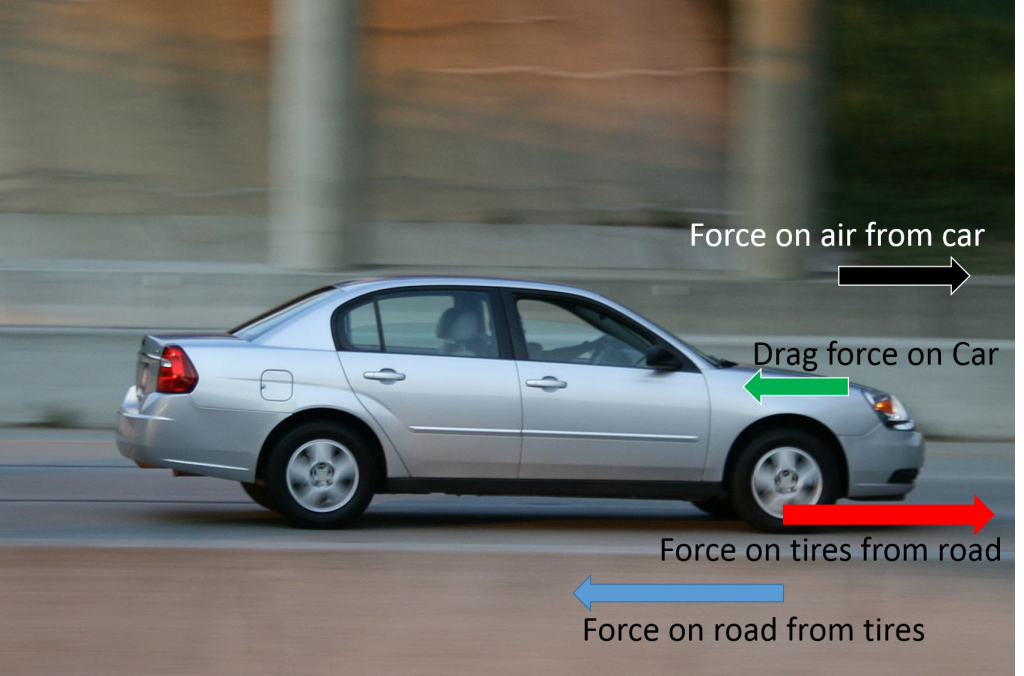62 Vehicular Locomotion
Driving
Everyday Example: Driving
In order for your car to accelerate along a flat road, it must have a net horizontal force. What force acts on your car to provide this net force? Remember the force must be on the car from another object, the car can’t put a net force on itself (so the answer can’t be the engine or any part of the car). Gravity and normal force are external forces on a car, but those forces act vertically and cannot contribute to a horizontal acceleration. The force that acts on your car in the horizontal direction is friction. When the tires attempt to rotate, they push against the ground via friction, and the ground pushes back with an equal reactionary friction force, according to Newton’s Third Law. Then, according to Newton’s Second Law, that friction force acting on the car causes it to accelerate. The purpose of the throttle, engine, and drive train is to cause the tires to push back on the road in order to receive the forward push from the road in return.

Also, your car pushes on the air to move it out the way, so according to Newton’s 3rd Law, the air puts a drag force back on your car. When the drag force and the friction force on the car are equal the car reaches a constant velocity, sort of like terminal velocity. If you want the car to go faster, you need to increase the friction force on the car from the road, which you achieve by increasing how hard the tires push against the road via the throttle, engine, and drive train successively.
Jet Propulsion
The flyboard in the previous video operates with an externally located pump that shoots water up the hose to the board which re-directs it downward. The momentum of the water was not conserved when it collided with the board, therefore it must have felt an impulse, a.k.a a net force for some amount of time. Newton’s Third Law tells us that the board must have felt an equal and opposite force back during that time, and that force must balance the weight of the board and rider when hovering in place.
Everyday Examples
Let’s estimate the mass flow rate (mass of water expelled per time) required just to hold up the board and a person. This video is helpful.
The board massof the board and rider is 93 kg, so multiplying by g (9.8 m/s/s) we get a weight of 911 N. The board must apply 911 N of downward force on the water in order to receive that same size upward force. The impulse on the water resulting from the downward force will change its momentum according to the Impulse-Momentum Theorem:
![]()
We don’t have a specific mass of water having a specific collision because the process appears continuous, but we could think image many tiny chunks of water colliding, (even to the point of individual water molecules). Assuming the water moves up the hose, bounces off the board, and exits at the same speed it entered, then the initial water momentum is just the opposite (negative) of the final momentum:
![]()
The double negative on the left becomes an addition:
![]()
Now if we divide each side by two and by the final velocity we can isolate the water mass:
![]()
We don’t know the ![]() for each individual water molecule collision, but we don’t need to. Dividing both sides by the time interval will give us the water mass that collides per time interval, which is exactly what we want:
for each individual water molecule collision, but we don’t need to. Dividing both sides by the time interval will give us the water mass that collides per time interval, which is exactly what we want:
![]()
Running the video in slow motion I made a very rough estimate of the water exit velocityand found 16 m/s downward. We already know the force on the water needs to be 911 N downward, so we can enter those values:
![]()
The board must redirect 30 kg of water each second in order to hold the rider. Water has a density of 1 Liter per kg, so 30 liters of water pass through the system each second. You may have noticed that “bouncing the water off the board, instead of just shooting it out like a rocket, reduced the flow rate by half. This is because this “bounce” doubled the impulse on the water (and back on the board). We will talk more about bouncy collisions in the next chapter.
Rocket Locomotion
Some machines actually use real chemical explosions for locomotion. For example, rocket fuel burns to produce hot, rapidly expanding gas which shoots out of the rocket backward, providing an impulse on the rocket. The force associated with that impulse is known as thrust. The analysis we used for the fly board doesn’t really work for the rocket because the mass of the rocket changes as it burns fuel, but that analysis is very interesting and you should ask your instructor about it.
Reinforcement Exercises
- Adapted from Fifth generation Chevrolet Malibu on Interstate 85 in Durham, North Carolina by Ildar Sagdejev (Specious) - Own work, CC BY-SA 3.0, via wikimedia commons ↵
the outward force supplied by an object in response to being compressed from opposite directions, typically in reference to solid objects.
the change in velocity per unit time, the slope of a velocity vs. time graph
a force that acts on surfaces in opposition to sliding motion between the surfaces

